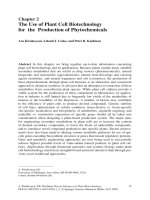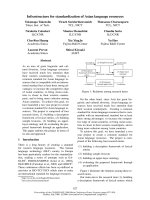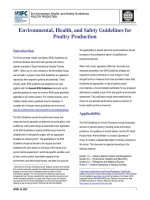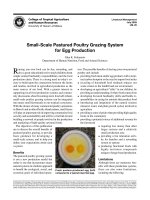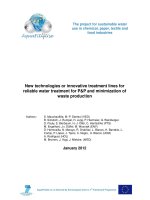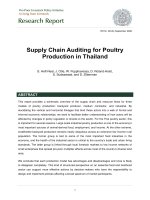Standardization of suitable treatment for sucker production of malbhog (AAB) banana through macropropagation
Bạn đang xem bản rút gọn của tài liệu. Xem và tải ngay bản đầy đủ của tài liệu tại đây (167.56 KB, 5 trang )
Int.J.Curr.Microbiol.App.Sci (2018) 7(5): 3555-3559
International Journal of Current Microbiology and Applied Sciences
ISSN: 2319-7706 Volume 7 Number 05 (2018)
Journal homepage:
Original Research Article
/>
Standardization of Suitable Treatment for Sucker Production of
Malbhog (AAB) Banana through Macropropagation
Dorodi P. Duarah1*, Subhanakar Saha1, D.N. Hazarika2,
Supriya Langthasa2 and Rupshree Borah2
1
Department of Horticulture, Assam Agricultural University, Jorhat-785013, Assam, India
2
B. N. College of Agriculture, Assam Agricultural University,
Biswanath Chariali - 784176, Assam, India
*Corresponding author
ABSTRACT
Keywords
Treatments, BAP,
Trichoderma viride,
Malbhog,
Macropropagation,
Regeneration
Article Info
Accepted:
26 April 2018
Available Online:
10 May 2018
The investigation entitled “Standardization of suitable treatment for sucker production of
Malbhog (AAB) banana through macropropagation” was carried out at Instructional cum
Research Farm, Department of Horticulture, Biswanath College of Agriculture, Assam
Agricultural University, Biswanath Chariali with a view to standardize the best treatment
combination suitable for production of suckers of Malbhg (AAB) banana through
micropropagation. Ten Treatments were T 1 (Control), T2 (Trichoderma viride), T3 (30 g
BAP + 30 g Trichoderma viride), T4 (0.04 % BAP), T5 (0.04 % BAP+30 g Enriched
Compost), T6 (30 g Trichoderma viride + 0.04 % BAP + 30g Enriched Compost), T7 (200
g Azospirillum and 200 g PSB in 10 kg of vermicompost), T 8 (50 ppm GA3), T9 (0.25 %
IBA) and T10 (100 g Nitrogen/plant). Treatment combinations replicated thrice following
Randomized Block Design. Result of the investigation revealed that the corms treated with
BAP with Trichoderma viride (T3) produced the highest number of primary (3.07),
secondary (5.73), tertiary suckers (18.94) followed by 2.94, 4.82, 18.40 in T4 (BAP),
respectively. BAP (T4) recorded the shortest pseudostem (17.17 cm), highest number
(5.87) of the functional leaves, the broadest leaf (17.18 cm), highest number of primary
roots (24.72) and longest roots (46.56 cm). The highest benefit: cost ratio of 2.64 was
obtained in T4. Among the treatments, T4 (BAP @ 0.04 %) and T 3 (BAP @ 0.04 % +
Trichoderma viride @ 30 g have shown good results with higher number of suckers and
higher percentage of regeneration.
Introduction
Banana is an important fruit crop and
considered as cash crop providing food
security, nutrition and income for many small
farmers. Banana having a great extensive uses,
religious and economic values in India
including Assam, its whole plant is utilized for
worship, culinary and table purposes. Despite
of its economic importance, banana
production faces major challenges including
scarcity of high quality planting materials,
attack of insect pests and diseases. Demand
for pest free and high quality planting
materials has been on the increase in Assam.
Naturally regenerated suckers preferred by the
3555
Int.J.Curr.Microbiol.App.Sci (2018) 7(5): 3555-3559
farmers are more likely to carry pests and
diseases leading to reduce productivity and a
short lifetime of new plantations (Faturoti et
al., 2002). Commercial cultivation of banana
is greatly hindered by various biotic and
abiotic factors (Seshu Reddy et al., 1999),
which include scarcity of high quality planting
materials, diseases and pests, lack of
agricultural inputs and limited land space for
farming. Farmers mostly rely on natural
regeneration of existing plants for propagation
(Faturoti et al., 2002).
Tissue Culture (TC) is one of the available
propagation methods that produce planting
materials free from diseases and pests, with
genetic purity and uniform growth (Sheela and
Ramachandran, 2001). However, adoption has
been low due to high capital investment and
subsequent high cost of suckers. This has led
to the plantlets being too expensive for
majority of the small holders to acquire.
planted in each treatment as per technical
programme at a gap of 1 m.
Preparation of IBA solution
The corms under treatment T9 were dipped in
a bucket containing 0.25 per cent IBA solution
(2.5 g IBA per litre of water) for 30 minutes
prior to planting in the pits.
Preparation of BAP solution
BAP solution of 0.04 per cent was prepared by
mixing 40 mg BAP powder with sodium
Hydroxide Pallets (1 - 2 pieces) and 1 - 2
drops of ethanol for removing the residual
effect and added 1 litre of water. Four ml of
0.04 per cent BAP solution was poured into
the meristematic cavity of each corms planted
under treatments of T4 (0.04 % BAP), T5 (0.04
% BAP + 30 g Enriched Compost) and T6 (30
g Trichoderma viride + 0.04 % BAP + 30 g
Enriched Compost).
Materials and Methods
Preparation of GA3 solution
Preparation of planting materials
Four to five months old uniform size suckers
of Malbhog banana were collected from
disease free plantation of nearby areas. The
average weight of corms ranged from 400 500 g. The corms were cleaned by removing
the roots and detopped just above the junction
of corm and pseudostem. The roots of the
suckers were trimmed and surface of the
corms were scrapped well with sharp knife.
All the suckers were decapitated by cutting the
pseudostem just above the corm. The corms
were dipped in 0.3 per cent Bavistin solution
for 30 minutes and after taking out, they were
allowed to dry in shade for a day. The apical
meristem of each corm was removed by
scooping out to a depth of 2 cm for making a
cavity of 2 cm in diameter and corm was
given 4 - 6 cross wise cuts to avoid the water
stagnation. Four decorticated rhizomes were
GA3 solution of 50 ppm was prepared by
dissolving 50 mg GA3 powder in 1 litre of
water. Five ml of 50 ppm GA3 solution was
poured into meristematic cavity of each corm
planted under treatment T8.
Preparation of enriched compost
Enriched compost was prepared by mixing 17
kg Rock Phosphate with PSB (1 kg) and
Azospirillum (1 kg) in 100 kg of
vermicompost. Enriched compost @ 30 g per
pit was applied before planting of corm.
Decapitation of primary and secondary
suckers
The primary suckers were decapitated by
removing the growing points and 4 - 6
horizontal cuts were given for the young corm
3556
Int.J.Curr.Microbiol.App.Sci (2018) 7(5): 3555-3559
to produce secondary suckers thereby
producing tertiary suckers. The tertiary
suckers which developed 3 - 4 numbers of
leaves were separated from the mother corm
carefully causing minimum damage to the
roots. The corms with roots of the separated
tertiary plantlets were dipped into the Bavistin
solutions (0.3 %) for 30 minutes. The treated
tertiary suckers were transplanted in the
polybags having 5 – 6 pierced holes (15 cm x
20 cm size) at the bottom and lower sides of
the polybags. The growing medium for filling
of polybags were prepared by mixing soil and
decomposed cow dung at the ratio of 1: 1 and
1 kg „Bioveer‟ containing Trichoderma viride
per quintal of growing medium was mixed.
Light irrigation was done in polybags
immediately after transplanting to settle down
the media. The transplanted plantlets were
kept under shade in net house (50 % shade)
for hardening, i.e., for establishment of the
plantlets. The media in the polybags were kept
in moist condition by light irrigation as and
when necessary. The suckers were hardened
for 3 months (90 days) prior to transplanting
in the main field. Observations on vegetative
characters of suckers were recorded at 15 days
interval during hardening.
Results and Discussion
The data generated during experimentation in
field were statistically analyzed by
Randomized
Block
Design
(RBD).
Significance and non-significance of the
variance due to different treatments were
determined by calculating the respective „F‟
values using Microsoft Excel (MS Office ver.
2007) and „F‟ values as the method described
by Panse and Sukhatme, (1985).
Significant effects due to different treatments
were observed on production of primary
suckers. Among the different treatments, the
corms treated with BAP and Trichoderma
viride (T3) produced the highest (3.07) number
of primary suckers followed by 2.94 recorded
at T4 (BAP). However, there were no
significant differences in production of
primary suckers between the treatments, viz.,
T2, T3, T4 and T5. The corms treated with GA3
(T8) produced the lowest number of primary
suckers (1.0) which was significantly different
from all other treatments. The highest
production of secondary suckers (5.73) was
recorded in T3 (BAP + Trichoderma viride)
which differed significantly from the rest of
the treatments. Production of secondary
suckers in T4 (BAP) was 4.82 which were at
par with 4.53 recorded in T5 (BAP+ Enriched
Compost). The corms treated with BAP with
Trichoderma viride (T3) produced the highest
(18.94) number of tertiary suckers followed by
18.40 in T4 (BAP) and both of them differed
significantly from the rest of the treatments.
IBA treated corms (T9) produced 16.94
number of tertiary suckers followed by 16.76
in T10 (Nitrogen) and they were at par with
each other (Table 1).
The longest pseudostem (17.17 cm) was
recorded in at the end of hardening period
(90th day) average maximum height of tertiary
suckers became 35.67 cm in T8 (GA3) which
was different significantly from the rest of the
treatments. The shortest pseudostem (17.17
cm) was recorded in T4 (BAP) followed by
17.60 cm in T5 (BAP + Enriched Compost)
and 17.61 cm in T7 (Azospirillum + PSB) and
they were at par with each other. There was no
significant differences in pseudostem height
between T9 (IBA) and T10 (Nitrogen); and
between T1 (control), T2 (Trichoderma viride)
and T6 (Trichoderma viride + BAP +
Enriched Compost) (Table 1). Number of
leaves per sucker increased gradually from the
beginning to the end of the hardening period.
T4 (0.04 % BAP) recorded the highest (5.87)
number of the functional leaves and it was at
par with 5.77 in T5 (BAP + Enriched
Compost) and both the treatments differed
significantly from rest of the treatments.
3557
Int.J.Curr.Microbiol.App.Sci (2018) 7(5): 3555-3559
Table.1 Growth and Root parameters of Macropropagated Banana Suckers
Treatments
No. of Suckers
Primary
Height of
Secondary Tertiary pseudostem
(cm)
3.69
15.20
22.97
No. of Breadth No. of
Length
Leaves/ of Leaves Primary of
root
plant
(cm)
roots
(cm)
5.85
15.37
18.28
36.70
T1: Control
2.38
T2: T. viride (30 g)
T3: BAP (0.04 %) + T.
viride (30 g)
2.58
3.07
4.22
5.73
15.79
18.94
23.30
21.67
5.67
5.55
15.85
16.05
20.33
23.45
43.79
42.08
T4: BAP (0.04 %)
T5: BAP (0.04 %) +
Enriched compost (30 g)
T6: T. viride (30 g) + BAP
(0.04 %) + Enriched
Compost (30 g)
T7: Azospirillum (200 g) +
PSB (200 g) mixed in 10 kg
of vermicompost
T8: GA3 (50 ppm)
2.94
2.83
4.82
4.53
18.40
16.02
17.17
17.60
5.87
5.77
17.18
15.68
24.72
23.61
46.56
42.30
2.42
4.03
15.87
22.37
5.58
15.63
24.39
40.38
2.75
3.99
16.11
17.61
5.40
15.98
24.11
41.00
1.00
1.8
5.23
35.67
2.98
3.30
14.33
27.76
T9: IBA (0.25 %)
T10: Nitrogen (100 g/plant)
CD (P=0.05)
1.82
1.83
0.50
4.12
4.2
0.30
16.94
16.76
0.34
18.69
19.30
1.12
5.50
5.34
0.16
16.11
16.23
0.20
21.50
18.83
0.75
41.44
37.62
2.35
Table.2 Economics of production
Treatments
Benefit: Cost ratio
2.23
1.82
2.19
2.64
2.12
1.63
1.56
0.10
2.53
2.42
T1 (Control)
T2: (Trichoderma viride)
T3: (BAP + Trichoderma viride)
T4: (BAP)
T5: (BAP + Enriched compost)
T6: (T. viride + BAP + Enriched Compost)
T7: (Azospirillum + PSB)
T8: (GA3)
T9: (IBA)
T10: (Nitrogen)
The treatments of T2 (Trichoderma viride) and
T9 (IBA) produced equal number of leaves
(5.62) at the end of hardening of tertiary suckers
and they were at par with the leaf number of
5.55 and 5.58 produced by the tertiary suckers
treated earlier with T3 (BAP + Trichoderma
viride) and T6 (Trichoderma viride + BAP +
Enriched Compost), respectively. It was also
observed that there was no significant
difference between T7 (Azospirillum + PSB) and
T10 (Nitrogen) in production of leaves. The
lowest number of leaves (2.98) was recorded in
T8 (GA3) (Table 1).
Treatments had significant influence on breadth
of third leaf both at the beginning and at the end
of hardening period. The suckers treated with
BAP (T4) produced the broadest leaf at the end
3558
Int.J.Curr.Microbiol.App.Sci (2018) 7(5): 3555-3559
of hardening period (17.18 cm) and differed
significantly from all other treatments.
However, variation in breadth of leaf due to the
influence of treatments was noted both at the
beginning and at the end of hardening period.
Of course, the breadth of the leaves of the
suckers treated with GA3 (T9) was lowest, i.e.
3.30 cm at the end of hardening period (Table
1).
Primary roots developed by the tertiary suckers
differed significantly due to the different
treatments. At the end of hardening, production
of primary suckers increased in all the
treatments.
Tertiary
suckers
produced
significantly highest number of primary roots in
T4 (24.72) followed by T6 (24.39) and T7
(24.11).
On the other hand, primary suckers produced by
T5 (23.61) and T3 (23.45) were at par with each
other and significantly different number of
primary roots were produced in T9 (21.50) and
T2 (20.33). GA3 (T8) treated suckers produced
significantly lowest number of primary roots
both before hardening (2.78) and after
hardening (14.33) (Table 1).
The length of the longest roots of tertiary
suckers measured at the time of hardening
significantly increased at the end of hardening.
The highest length of roots (19.00 cm) was
found in T4 (BAP) followed by 18.35 cm in T2
(Trichoderma viride) and 17.87 cm in T7
(Azospirillum + PSB) which were at par with
each other.
At the end of hardening, length of the longest
roots increased significantly in the similar trend
as observed at the time of hardening. T4 (BAP)
recorded the longest (46.56 cm) roots and
differed significantly from the rest of the
treatments.
The highest benefit: cost ratio of 2.64 was
obtained in T4, i.e., corms treated with BAP
(0.04 %). The lowest benefit: cost ratio (0.10)
was calculated out in T8, i.e. corms treated with
GA3 (Table 2).
References
Faturoti, B., Tenkouano, A., Lemchi, J. and Nnaji,
N. (2002). Rapid Multiplication of Plantain
and
Banana:
Macropropagation
Techniques. A Pictorial Guide. Ibadan,
Nigeria: IITA. p. 12.
Panse, V. S. and Sukhatme, P. V. (1985).
Statistical method for agriculture workers.
ICAR, Pub. New Delhi.
Seshu Reddy, K. V., Ngode, L., Senyonga, J. W.,
Wabule, M., Onyango, M. and Adede, T. O.
(1999). Management of pests and diseases
of banana in Kenya: A Status Report.
Mobilizing IPM for suitable banana
production in Africa. Proceedings of a
workshop held in Nelpursuit. INIBAP.
Montepellier.
Sheela, V. L. and Ramachandran Nair, S. (2001).
Growth, flowering and yield potential of
tissue culture banana (Musa AAB cv.
Nendran). J. Tropical Agriculture. 39: 1-4.
How to cite this article:
Dorodi P. Duarah, Subhanakar Saha, D. N. Hazarika, Supriya Langthasa and Rupshree Borah. 2018.
Standardization of Suitable Treatment for Sucker Production of Malbhog (AAB) Banana through
Macropropagation. Int.J.Curr.Microbiol.App.Sci. 7(05): 3555-3559.
doi: />
3559
